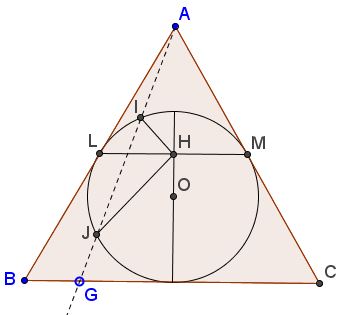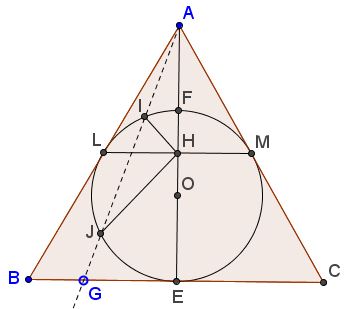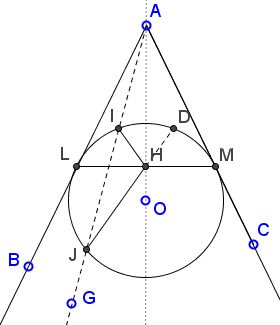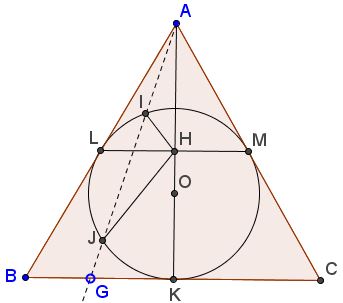Circle of Apollonius in Equilateral Triangle
The problem below has been kindly posted by Leo Giugiuc at the CutTheKnotMath facebook page. Leo credits the problem to Ruben Dario.
The problem came up in the universal language of mathematics accompanied by a diagram:

|Contact| |Front page| |Contents| |Geometry| |Up|
Copyright © 1996-2018 Alexander Bogomolny
I shall reformulate the problem by introducing more suitable notations.
The incircle $(O)$ of an equilateral triangle $ABC$ touches $AB$ in $L$ and $AC$ in $M.$ $H$ is the midpoint of $LM.$ For $G$ on $BC,$ let $AG$ meets $(O)$ in $I$ and $J.$

Prove that $4\cdot HI\cdot HJ =3r^{2},$ where $r$ is the radius of $(O).$
Solution 1
Define $E$ and $F$ as shown below:

Due to the properties of equilateral triangle
$AF:HF=AE:HE\,(=2.)$
This means that $(O)$ is the Circle of Apollonius for points $A$ and $H,$ implying, in particular, that
$\displaystyle\frac{AI}{HI}=\frac{AJ}{HJ}=2,$
from which $AI\cdot AJ = 4\cdot HI\cdot HJ.$
On the other hand, by the Power of a Point theorem,
$\displaystyle AI\cdot AJ=AL^{2}=3r^{2}$
because $\displaystyle AL=\sqrt{3}r.$
Solution 2
This solution is based on the following observation
Let circle $(O)$ inscribed into angle $BAC$ touches side $AB$ at $L$ and side $AC$ at $M;$ let $H$ denote the midpoint of $M.$ Draw a secant $AG$ that intersects $(O)$ in $I$ and $J.$ Finally, assume $D$ is the second intersection of $JH$ with $(O).$

Then $HI=HD.$
With this and the Intersecting Chords Theorem, the solution is immediate
$\displaystyle a\cdot b = HI\cdot HJ = HD\cdot HJ = LH\cdot MH = LH^{2}=\bigg(\frac{\sqrt{3}}{2}r\bigg)^{2}.$
Solution 3
We'll use complex numbers: $x$ will be the complex number associated with point $X.$ Let $K$ be the midpoint of $BC;$ $\displaystyle \omega = -\frac{1}{2}+i\frac{\sqrt{3}}{2}$ such that $\omega^{2}+\omega +1=0.$ Let $O$ be the origin.

Then $m=k\omega,$ $l=k\omega^{2}.$ Since $ALKM$ is a rhombus, $a+k=l+m=k(\omega +\omega^{2})=-k,$ implying $a=-2k.$ As the midpoint of $LM,$ $\displaystyle h=-\frac{k}{2}.$ Set also $I=ku$ and $J=kv,$ with $|u|=|v|=1.$ Then
$\begin{align}\displaystyle HI&=k\sqrt{\bigg(u+\frac{1}{2}\bigg)\bigg(\overline{u}+\frac{1}{2}\bigg)}\\ &=k\sqrt{\bigg(u+\frac{1}{2}\bigg)\bigg(\frac{1}{u}+\frac{1}{2}\bigg)}\\ &=\frac{k}{2}\sqrt{\frac{(u+2)(2u+1)}{u}}. \end{align}$
Similarly, $\displaystyle HJ=\frac{k}{2}\sqrt{\frac{(v+2)(2v+1)}{v}}.$ Thus
$\displaystyle HI\cdot HJ=\frac{k^{2}}{4}\sqrt{\frac{(u+2)(2u+1)(v+2)(2v+1)}{uv}}.$
On the other hand,
$\begin{align}\displaystyle AI&=k\sqrt{(u+2)(\overline{u}+2)}&=k\sqrt{\frac{(u+2)(2u+1)}{u}},\\ AJ&=k\sqrt{(v+2)(\overline{v}+2)}&=k\sqrt{\frac{(v+2)(2v+1)}{u}}. \end{align}$
Therefore, $\displaystyle AI\cdot AJ=k^{2}\sqrt{\frac{(u+2)(2u+1)(v+2)(2v+1)}{uv}},$ giving $4 HI\cdot HJ=AI\cdot AJ.$ It remains only to observe that, by the Intersecting Chords Theorem, $AI\cdot AJ=3r^{2}.$
Acknowledgment
Solution #2 is by René Sperb, solution #3 is by Leo Giugiuc.
|Contact| |Front page| |Contents| |Geometry| |Up|
Copyright © 1996-2018 Alexander Bogomolny
73498835
